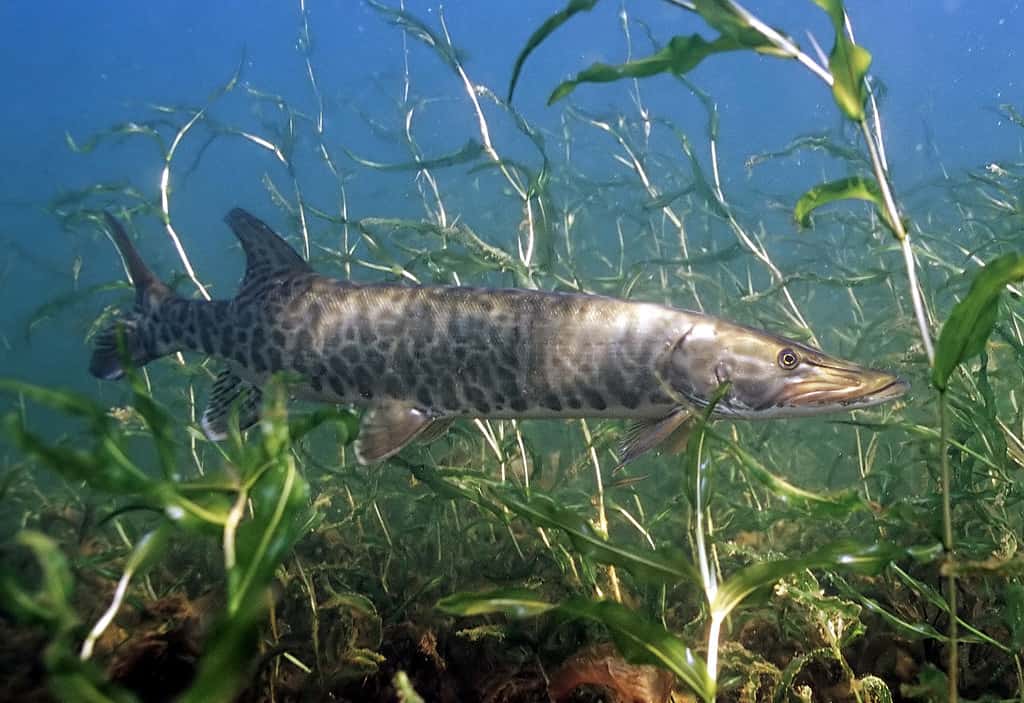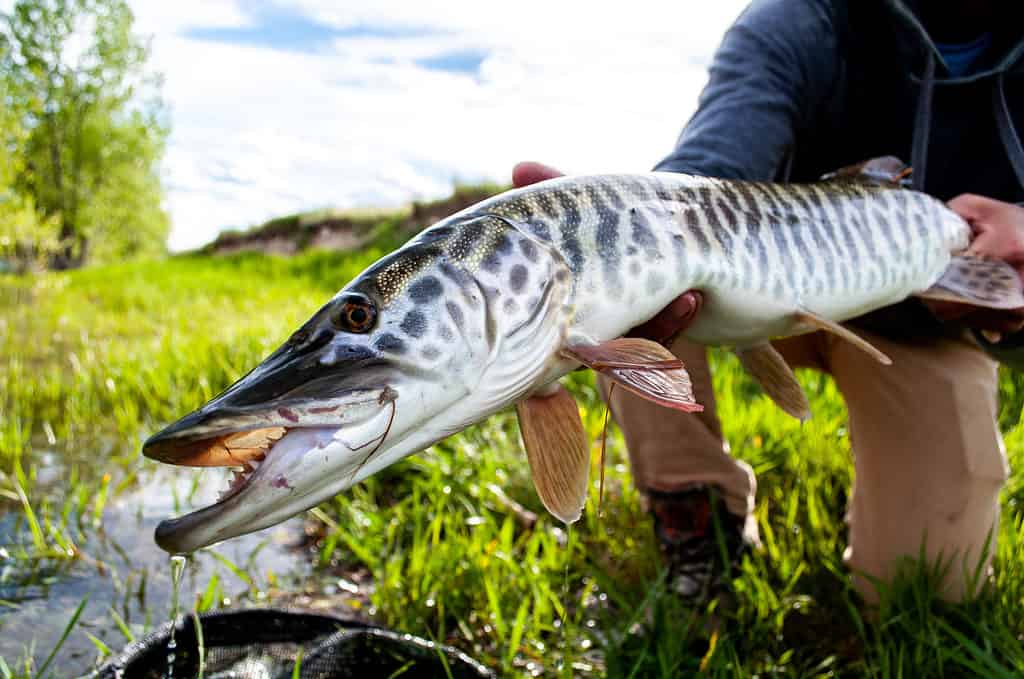Muskellunge fish swim in Canada and the northern United States and were introduced to 31 U.S. eastern and western states as sport fish in the 1950s. Musky are notoriously difficult to catch and reach epic proportions that anglers dream of. Their huge size means they’re apex predators in all their native waters and most of their introduced waters. This article will uncover musky size comparisons and just how big they get with everyday examples to illustrate their unbelievable proportions.
What Is a Musky?
The muskellunge (Esox masquinongy) is the largest pike (Escocidae) family member. It’s a type of predatory fish that’s native to the Mississippi River basin, Hudson Bay, the Great Lakes, and the St. Lawrence River.
These carnivorous predatory fish have elongated bodies, flat heads, and low-set fins. Color varies, but most show up in brown, green, and light gray with dark vertical side stripes.

Muskies are predator fish with elongated bodies, camouflage stripes, and flat heads with sharp teeth.
©Engbretson, Eric / U.S. Fish and Wildlife Service, Public domain, via Wikimedia Commons – License
Three subspecies are recognized:
- E. m. masquinongy: The Great Lakes musky, also called the “spotted musky” because its vertical dots form its side stripes.
- E. m. ohioensis: The barred musky/Chautauqua musky is from the Ohio River system, St Lawrence River, Lake Ontario, and Chautauqua Lake.
- E. m. immaculatus: The clear musky is found inland. It is most often seen in Minnesota, Wisconsin, northwest Ontario, and southeastern Manitoba’s lakes.
The subspecies have slightly different markings but tend to reach the same length and weight proportions.
There is also a fish called a tiger musky. It’s an infertile cross between a muskellunge and northern pike. In terms of size, they don’t quite reach the epic proportions of a pure musky, but they’re still highly sought-after game fish.

Tiger
musky is an infertile crossbreed between musky and northern pike.
©Jennifer de Graaf/Shutterstock.com
Musky Sizes
A musky is one of the largest fish in its native waters. On average, a musky typically reaches 28-48 inches long and weighs up to 36 lbs. However, musky size reaches all the way to six feet long and 70 lbs in weight.
Tiny juvenile muskies emerge from the egg and are vulnerable to predators but grow rapidly. By the first winter season, newly hatched muskies reach an average of 12 inches long.
Musky Size Comparison
Muskies are large fish compared to other species roaming the same waters, so they’re apex predators, and one of the most exciting angler catches. Fish in the same waters include:
- Yellow perch – average 7.5 inches
- Whitefish – average 14-20 inches
- Ciscoe – average 15 inches
- Bullheads – average 10 inches
- Smallmouth bass – average 28 inches
Musky prey on all the fish that share its water, plus most animals that venture in, such as ducklings, frogs, and even fully grown ducks. Muskies have enormous stomachs for their size. They can eat creatures up to 2/3 of their body length.
To clarify things, here are a few examples of musky size compared to people and everyday objects.
A typical musky reaches a maximum of 48 inches (that’s four feet). That’s comparable to:
- An average seven-year-old child’s height
- Four school rulers of 12 inches
- Regulation height hockey net
The weight of an average musky is 36 lbs. That’s approximately the same weight as:
- A cinder block
- An American bull terrier
- Seven computer monitors
- An average four-year-old

Average-sized muskies can weigh the same as an American bull terrier.
©KruBeer Photo/Shutterstock.com
But that’s nothing! The largest muskies reach 72 inches, which is six feet long. Let’s see what compares:
- A tall human
- Length of a mattress
- Height of a fridge
- The height of a bison
The largest muskies tip scales at 70 lbs. What else weighs 70 lbs?
- A standard workbench
- Bear cub
- Basketball stand
- Gray wolf
Whew! If you’re angling for a giant musky, you’ll need a bigger boat.
Musky: Species Overview
Musky have the unofficial nickname “fish of 10,000 casts” because they are clever and difficult to catch. These intelligent fish recognize artificial lures and very quickly identify spots where anglers lurk.
Appearance
Muskies are camouflaged in green, brown, or silver with dark side stripes. A forked tail, flat head, and powerful elongated body lend them speed. Sharp pointed teeth grab and hold prey before it’s swallowed. A musky’s teeth also pose a danger to anglers as they bite when landed.
Anglers say an adult musky is the equivalent of a freshwater Great White Shark in terms of temperament and aggression.
Diet
A musky will eat anything it can fit in its mouth and swallow. We’ve seen that adults take fish, frogs, ducklings, and even adult ducks, but their preferred diet is smaller fish. It’s not unknown for muskies to grab small mammals drinking from the water’s edge, including muskrats, mice, and squirrels.
Juveniles eat zooplankton, insects, and crustaceans; as they grow, other fry appear on their menu.

Adult musky can tackle a duck, although ducklings are a more frequent target.
©2009fotofriends/Shutterstock.com
Spawning
Musky fish spawn in mid to late spring in slow-moving, shallow areas with lots of vegetation. Muskies prefer a sandy bottom because this prevents their eggs from floating away or sinking in stifling mud. Spawning is completed after five to 10 days, and the eggs are left to fend for themselves.
Habitat
Muskies live in large, clear, freshwater lakes and rivers and prefer 20 feet of water and weedy areas with covers such as overhanging vegetation, rocks, bridge supports, and sunken trees. They lurk in these areas, grabbing prey that swims by.
It’s a cold water species that prefers temperatures of 67 to 72 degrees. In warmer waters, they don’t spawn as successfully.
Predators
It’s only really humans and bald eagles that prey on adult muskies. They are just too large for other animals to take. Juveniles have a rougher time, though. Most carnivorous fish, such as northern pike, eat them along with frogs, crustaceans, and birds.
The Largest Musky Ever Caught
The official largest musky ever caught was snagged in July 1949 by Cal Johnson near Hayward, Wisconsin. It weighed in at 67.8 lbs and was 60.25 inches long. Larger records exist, but they are controversial.
The previous record musky weighed 69 lbs and 15 oz. Caught in the St Lawrence River in 1957 by Arthur Lawson. The record was revoked when modern experts examined the photographs and deemed the weight exaggerated.
The Largest Freshwater Fish
Muskies are certainly one of the largest freshwater fish in the United States, but when it comes to the very largest, they are mere minnows.
The world’s largest freshwater fish is the beluga sturgeon. These immense fish reach 23 feet 7 inches long and weigh 3,463 lbs. In the U.S., the largest freshwater fish is the white sturgeon which reaches 20 feet long and 1,800 lbs.
Best Places and Time of Year to Catch Musky
Inspired by musky size comparisons and the idea of an exciting water fight? Musky fishing it is, but where to go?
The best places to hook musky fish include:
- Michigan
- Wisconsin
- Minnesota
- Great Lakes
- St. Lawrence River
- Mississippi Valley
- Chattanooga Tennessee River Valley
- Sabaskong Bay on Lake of the Woods, Canadian–United States boundary
- Wabbigoon Lake, Ontario
The Great Lakes and Lake St. Clair frequently reveal monster-sized musky and are, therefore, two of the most popular places to fish.
Floridians will have to set sail for cooler waters as muskies can’t cope with the hot water there.
Whatever lake or river you cast for musky, look for stumps, rock bars, vegetation, ledges, and sunken objects. Chances are a mega-musky is lurking there, just waiting for a baitfish to swim by.
Muskies are active year-long, but anglers suggest that spring and late fall are the best musky fishing seasons because it’s transition time and the water is cooler.
Spring: Melting ice means clear, cool water that muskies love. At this point, musky stay close to their spawning ground, ready for temperatures to rise. Search for deep water near a known spawn site to up your chances of hooking a river monster.
Summer: Avoid midday because water temperature puts muskies off much activity. Fish in the early morning or late evening.
Fall: Fall is probably the best time of year to hunt musky. At this point, they’re fattening up, ready for winter, and eat just about anything they can find. You can fish right up until the water ices over.

Fall is the best time to fish for a musky because they’re fattening up for winter.
©LIKE HE/Shutterstock.com
What Size Is a Musky Fish?
An average musky weighs 36 lbs and reaches 28-48 inches long, which is approximately the same weight as a seven-year-old child and the same height as a hockey net.
However, musky can reach epic proportions. The largest musky reach six feet and weigh up to 70 lbs. That’s as tall as a refrigerator and heavy as a basketball stand.
The photo featured at the top of this post is © M Huston/Shutterstock.com
Thank you for reading! Have some feedback for us? Contact the AZ Animals editorial team.






